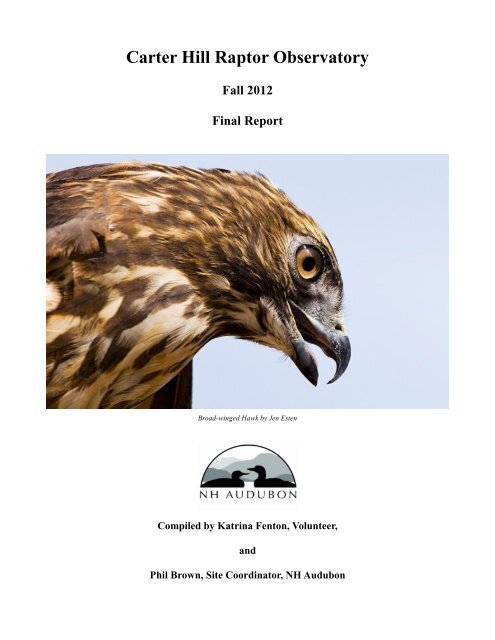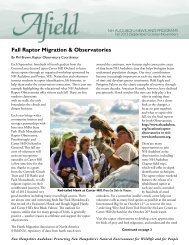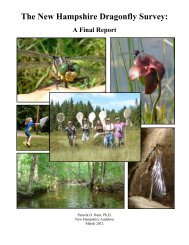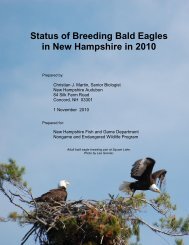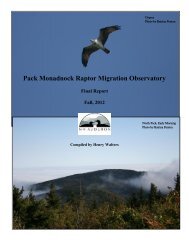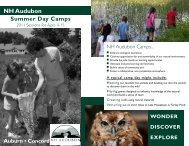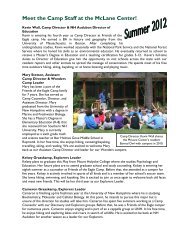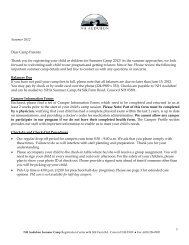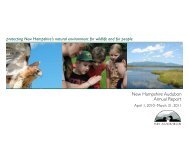Carter Hill Raptor Observatory - New Hampshire Audubon
Carter Hill Raptor Observatory - New Hampshire Audubon
Carter Hill Raptor Observatory - New Hampshire Audubon
Create successful ePaper yourself
Turn your PDF publications into a flip-book with our unique Google optimized e-Paper software.
<strong>Carter</strong> <strong>Hill</strong> <strong>Raptor</strong> <strong>Observatory</strong><br />
Fall 2012<br />
Final Report<br />
Broad-winged Hawk by Jen Esten<br />
Compiled by Katrina Fenton, Volunteer,<br />
and<br />
Phil Brown, Site Coordinator, NH <strong>Audubon</strong>
History & Mission<br />
The <strong>Carter</strong> <strong>Hill</strong> <strong>Raptor</strong> <strong>Observatory</strong> was founded by <strong>New</strong> <strong>Hampshire</strong> <strong>Audubon</strong> (NHA) in 2008<br />
after being discovered as a good place to watch migrating hawks by local birders, Bob Quinn, Joe<br />
Quinn, and Rob Woodward the previous fall. A follow-up visit by NHA staff sparked interest in<br />
establishing a hawk watch at this location because of its impressive views from an observation<br />
platform, combined with its proximity to NHA‟s Concord headquarters and the high potential for<br />
outreach to the public. <strong>Carter</strong> <strong>Hill</strong> Orchard owner, Rob Larocque, willingly agreed with the request, and<br />
the partnership between NHA and the Orchard, a pick-your-own location in Concord, NH was founded.<br />
Since the fall of 2008, tens of thousands of visitors have spent time at the raptor observation platform<br />
and have had the chance to interact with NHA staff and volunteers and learn about raptor migration.<br />
NHA‟s stated mission is to protect <strong>New</strong> <strong>Hampshire</strong>‟s natural environment for wildlife and<br />
people, and it fulfills this role at the <strong>Observatory</strong> through both raptor migration research and<br />
educational outreach. <strong>Raptor</strong> and weather data that are taken by volunteers and staff are entered on<br />
HawkCount.org, an international hawk migration database run by the Hawk Migration Association of<br />
North America (HMANA), where it contributes to a larger understanding of raptor migration.<br />
Education is presented informally each day, with volunteers doing the bulk of the outreach. Staff<br />
programs and periodic special events are another component of the educational project.<br />
The autumn view to the north from the <strong>Carter</strong> <strong>Hill</strong> <strong>Raptor</strong> <strong>Observatory</strong> platform. Photo by Tom Brewton
The 2012 Season<br />
This fall migration season at <strong>Carter</strong> <strong>Hill</strong> <strong>Observatory</strong> was unique in many ways, from the lack of<br />
one “official counter”, to a record amount of hours logged, to the diversity of birds observed. Record<br />
numbers were posted for fourteen of the sixteen species counted this season, including a site-first Black<br />
Vulture. The raptors weren't alone in the skies – thousands of other migrants crossed over the orchard,<br />
including individuals from the avian, insect, and mammalian worlds. The drama of life was played out<br />
as dragonfly fed songbird and songbird fed Accipiter. All while the site‟s growing cadre of human<br />
visitors enjoyed, experienced, and awed at the seasonal spectacles unfolding before their eyes, day after<br />
day. Visitation to the hawk watch platform itself totaled well over 3,000 for the season, with far greater<br />
numbers aware of the education and research efforts through visiting the host location, <strong>Carter</strong> <strong>Hill</strong><br />
Orchard.<br />
This was the <strong>Observatory</strong>‟s fifth consecutive season functioning as a hawkwatch of <strong>New</strong><br />
<strong>Hampshire</strong> <strong>Audubon</strong> (NHA). Through each of its first five seasons, the site has grown and evolved.<br />
This season, in particular, saw a dramatic rise in the number of hours invested at the site, as a core<br />
group of <strong>Carter</strong> <strong>Hill</strong> faithful has flourished. But the season was not without its challenges. Past official<br />
counter since the project‟s inception, Robert Vallieres, was unexpectedly prevented from leading the<br />
count, but he was able to return as a regular observer for much of the season. A host of volunteers rose<br />
to the challenge of ensuring the site would receive full coverage, ultimately combining for a total of<br />
417.75 hours from September 1 st until November 20 th . This hourly total is a significant increase from<br />
the past season high of 326 observation hours tallied in 2011. A total of 7,142 individuals of 16 species<br />
of raptors (including vultures, for our purposes) were tallied during the 2012 season. This is the secondhighest<br />
total raptor count in the site‟s five years, and almost all species set single-season records.<br />
<strong>Raptor</strong>s included, an impressive total of 101 bird species were observed throughout the course of the<br />
season from or below the raptor observation platform.<br />
The official count period at <strong>Carter</strong> <strong>Hill</strong> runs from September 1 st to October 31 st . The 2012<br />
season was the first to document more than casual observations late into the month of November, a<br />
time frame that can contribute important insight into understanding the complete picture of the fall<br />
migratory season. Among the notable results was the demonstration for a strong case for continuing this<br />
extended coverage – a theme that has been elaborated on further in the 2012 final report for Pack<br />
Monadnock <strong>Raptor</strong> Migration <strong>Observatory</strong>, which is also operated by NHA.<br />
Hourly totals were collected for each species, as well as details on the weather such as wind<br />
speed, wind direction, temperature, visibility, precipitation, and cloud cover. This season, a much<br />
broader effort was made to record non-raptor migrants and the number of visitors who come to the<br />
observatory. As mentioned prior, data are collected following HMANA protocol and are submitted to<br />
HawkCount.org, where they contribute to a larger dataset, available for in-depth analysis beyond what<br />
is covered in both this report and by NHA in its own analysis of raptor migration trends. Complete<br />
hourly results and daily reports are available to readers at this website.<br />
Finally, it is our pleasure to provide you with this document for the first time in the site‟s young<br />
history. Our first written final report that documents the hawk watching season is now a reality, and we<br />
hope to continue this momentum as we move forward and continue to become established as one of the<br />
more recognized hawk watches in northern <strong>New</strong> England.
Education and Outreach<br />
The platform at <strong>Carter</strong> <strong>Hill</strong> is situated right in the middle of <strong>Carter</strong> <strong>Hill</strong> Orchard – a position that<br />
provides the opportunity to introduce hundreds of visitors to hawkwatching every season. Over 3,000<br />
visitors were recorded this fall, but the actual number of people who experienced the hawkwatch was<br />
far greater as there were quite a few days when visitor totals were not recorded. Most visitors come to<br />
the platform as apple-pickers and sight-seers, but many leave as hawkwatchers, learning about<br />
everything from the finer points of Accipiter identification to the conservation status of various species.<br />
Kids and adults alike get lost in the beauty of a bald eagle soaring overhead or the seemingly endless<br />
parade of broad-wingeds and sharp-shinneds across September skies. Even the bulky shape of a local<br />
red-tailed perched across the field is often enough to inspire people to return. NHA provides loaner<br />
binoculars for guests, and educational materials both for sale and for display. Knowledgeable<br />
volunteers are always ready to point out a bird or answer any raptor quandaries.<br />
The <strong>Carter</strong> <strong>Hill</strong> <strong>Raptor</strong> <strong>Observatory</strong> was founded by NHA with a strong educational mission that<br />
grows every year. School groups are a regular sight at the orchard, and, together with our partner,<br />
Project SEE, NHA coordinates a hands-on education program on raptors for local fourth grade classes<br />
each fall that culminates in a field trip to the hawkwatch. This year their visit coincided with the busiest<br />
day of the season, September 20 th , as 1,259 raptors poured through the skies. All 200+ students were<br />
treated to raptors when they visited the platform, as well as live bird demonstrations and programs in<br />
other parts of the Orchard. Other groups from kindergardeners to high-schoolers to international tourists<br />
to local garden clubs found their way to the <strong>Observatory</strong>, where they not only learned about raptors, but<br />
also contributed to the success of the count by effectively becoming observers themselves.<br />
View of apple pickers and orchard below. Photo by Phil Brown
The most popular public event on the project‟s annual calendar is the <strong>Raptor</strong> Release event,<br />
which occurred this fall on September 16 th . On this day, a rehabilitated immature Cooper's hawk –<br />
which was nursed back to health by Maria Colby of Wings of Dawn in Henniker, NH – was brought to<br />
the Orchard to be returned to the wild. Some 500+ people visited the hawkwatch, 250 of whom<br />
remained for the release. Thanks in part to excellent press coverage and by word of mouth, this event<br />
continues to attract visitors from far and wide, sparking interest in raptors and providing an opportunity<br />
for people to witness firsthand a hawk beginning its long migratory journey. There is potential in the<br />
future to perform multiple releases in a season, and judging from the successes of past experiences, this<br />
will be an excellent way to involve even more people in the world of hawkwatching and conservation.<br />
Robert Vallieres with Cooper‟s Hawk, and Mike Bartlett, President of NH <strong>Audubon</strong>, looking on. Photo by Jen Esten<br />
Specially-trained volunteers, particularly, Robert Vallieres, sometimes brings live birds from<br />
NHA's McLane Center to give people a closer look at the species that pass overhead NH each fall.<br />
These injured „ambassador birds‟ – incapable of ever being released into the wild themselves – never<br />
fail to generate excitement. This was particularly true this season on the day when Robert was able to<br />
bring the bald eagle for the first time. A bird in the hand gets people looking to the skies, and the birds<br />
themselves often acted as observers, keying in on their wild relatives high overhead. Look for these<br />
programs again in the coming season on key weekend dates.<br />
Other events included participation in the International Big Sit, an annual bird-counting event,<br />
on which Katrina Fenton counted only two species at <strong>Carter</strong> <strong>Hill</strong> in 2012 due to the poor weather. In<br />
addition, an indoor/outdoor raptor identification workshop was again provided by Phil Brown to new<br />
and veteran hawk watchers on site, and NHA anticipates offering more of these programs next year.
Results<br />
Over the course of the fall, 7,142 raptors of 16 species were counted migrating past <strong>Carter</strong> <strong>Hill</strong>,<br />
7,046 of them in the official count period of September 1 st to October 31 st . The additional 96 birds<br />
counted in the 46.25 hour logged in November may not seem too significant when looking at overall<br />
numbers, but they accounted for the only rough-legged hawks, among a few other notable species and<br />
numbers. The site‟s first record of a black vulture came through on September 21 st , making history as<br />
the first of its kind to be observed in the entirety of Concord! Two golden eagles were also observed,<br />
the highest season total for this species in the five years of hawk watching at the <strong>Observatory</strong>.<br />
Many raptor species showed a record increase over previous seasons‟ numbers, and MOST<br />
species set new season records in 2012. There are several factors that this may be attributed to, and<br />
analysis of a single season of migration cannot be used on its own to make accurate determinations<br />
about actual population size of species. Still, some observations about this season can be made. The<br />
2012 season had more observers scanning the skies, and far more hours were logged this year (418)<br />
than any past season. Observer hours have grown consistently at the <strong>Observatory</strong> each of the past four<br />
years. As observer experience builds, individuals have become more adept at finding and identifying<br />
birds, a trend that we hope to carry into future seasons.<br />
With the exception of a couple of significant weather events, including Hurricane Sandy in late<br />
October, which shut down migration – and the hawk watch – for several days, there were generally<br />
excellent weather conditions for migrants for much of the count. The first part of October, when most<br />
species reached their peaks, was notable. Also, many raptor populations are holding steady or on the<br />
rise, and we should continue to expect bald eagle, Cooper's hawk, peregrine falcon, and turkey vulture<br />
numbers to grow. For other species like the American kestrel and Northern harrier, which are both in<br />
decline, their heightened numbers could reflect a good flight year where conditions were potentially<br />
favorable on breeding grounds, or, for simply ushering more birds than usual over the <strong>Observatory</strong>. The<br />
overall season total was lower than 2011‟s record season as fewer broad-winged hawks were tallied, but<br />
it was still an above-average count.
Species Accounts<br />
The following species accounts show the total number or birds during the official count period<br />
of September 1 to October 31, 2012. Daily high count totals are also listed. Numbers followed by an<br />
asterisk indicate new high counts for the <strong>Observatory</strong>. November totals are listed separately.<br />
Volunteer, Katrina Fenton, duly noting everything and anything with wings. Photo by Tom Brewton
Black Vulture (Coragyps atratus)<br />
Season Total: 1 (September 21) * 1 st Site Record<br />
The site‟s first – and, as it turned out, Concord‟s first – black vulture was spotted by Phil Brown<br />
as it soared with two turkey vultures on a hazy late September afternoon. Sam Lewis and Bob Quinn<br />
were also on hand, and Bob, who has a lifelong passion of studying birds in Concord, had excellent<br />
timing, arriving just in time to observe a few of the vulture‟s characteristic quick flaps. Though it<br />
appeared that this flight strategy would bring the bird nowhere on such a soupy day, the three vultures<br />
were indeed migrating along a southwestern trajectory typical of the vultures seen from <strong>Carter</strong> <strong>Hill</strong>. The<br />
sighting of a black vulture is still cause for excitement among <strong>New</strong> <strong>Hampshire</strong>‟s birding community,<br />
but with this species‟ northward expansion, it may only be a number of years before this bird becomes a<br />
regular visitor to the hawk watch.<br />
Black (left) and turkey (right) vultures. Photo by Phil Brown<br />
Turkey Vulture (Cathartes aura)<br />
Season Total: 223 High Count: 95 (Oct. 9)*<br />
The classic “V” of a turkey vulture's dihedral was a frequent sight teeter-tottering over the<br />
hawkwatch. Local birds made their daily appearances through the first half of the season, their numbers<br />
augmented, then replaced by migrants. The peak of migration occurred between Oct. 5 th and Oct. 13 th<br />
with 145 turkey vultures counted. Two sizable kettles were observed on 10/9, one of 45 birds, clouding<br />
a thermal like giant, melanistic broad-winged hawks. The rather ghastly appearance of a close perched<br />
turkey vulture is lost when the bird becomes airborne, transforming into a master soarer capable of<br />
riding the faintest puff of breeze or stiffly-blowing gale with equal grace. Turkey vultures continue to<br />
expand their range northward through <strong>New</strong> England and beyond every year.
Osprey (Pandion haliaeetus)<br />
Season Total: 234* High Count: 50 (Oct. 5)*<br />
One of the most readily identifiable birds at the hawkwatch, the osprey, made a strong showing<br />
this season. Both the Contoocook River and Long Pond (Penacook Lake) lie in close proximity to the<br />
site and probably serve as corridors for this species, which often represented the first raptor in the<br />
morning and the last in the evening from the platform. The first wave of osprey pushed through on<br />
September 21 st with 23 birds counted. Migration peaked between October 2 nd and October 7 th , with 100<br />
moving through during this time frame. Since the DDT era, the osprey has experienced an amazing<br />
resurgence, and evidence indicates they are even more plentiful in some parts of their range than they<br />
historically were so. A few times, an osprey was observed carrying fish past the site, “packing a lunch”.<br />
Osprey in flight. Photo by Phil Brown<br />
Bald Eagle (Haliaeetus leucocephalus)<br />
Season Total: 150* High Count: 12 (Sep. 18) November – 2<br />
On October 7 th , <strong>Carter</strong> <strong>Hill</strong> reached a milestone, becoming the first <strong>New</strong> <strong>Hampshire</strong> hawkwatch<br />
to reach 100 Bald Eagles in a season. No one could have guessed at that point that number would end<br />
up being only two-thirds of the season total. Few days went by without an eagle, and days of several<br />
individuals were commonplace. Oftentimes, multiple eagles could be seen flying together, pairs of<br />
youngsters, adult birds, or mixed groups gliding south. Another rampant success story of the raptor<br />
world, eagles may be returning as breeding birds more quickly than any other species of raptor. The<br />
bald eagle continues to recover as the years pass from its recent removal from the federal endangered<br />
species list, and it continues to be „downgraded‟ from the most-threatened species it used to reside<br />
among. The sight of an eagle never failed to bring out the hawkwatcher in anyone who saw one.<br />
Included in the lucky observers were hoardes of Concord 4 th graders one particularly memorable day.
Northern Harrier (Circus cyaneus)<br />
Season Total: 86* High Count: 15 (Oct. 9)*<br />
When watching a Northern harrier leisurely work a patch of Phragmites in a coastal habitat, one<br />
might not peg this graceful, long-winged raptor as being champion migrants. Their buoyant flights and<br />
exaggerated wing beats make them appear more like giant butterflies than like raptors. From a<br />
hawkwatch, they show their true mettle: long-tailed pin dots impossibly high overhead, determined<br />
flyers powering on past the sunset when everything else has gone to roost. This season provided many<br />
memorable sightings, from a pair riding a nearby thermal to the last bird of the day on the Big Sit, one<br />
of only two raptor species observed during this particular year‟s International Big Sit.<br />
Northern harrier. Photo by Katrina Fenton<br />
Sharp-shinned Hawk (Accipeter striatus)<br />
Season Total: 1267* High Count: 166 (Oct. 5)* November – 9<br />
The ubiquitous sharp-shinned hawk, frequenter of backyard feeding stations and woodland<br />
edges, could well be called the lifeblood of the site. Only the broad-winged hawk posted higher<br />
numbers, but, unlike their Buteo cousin, sharp-shinneds make up for the discrepancy by passing<br />
overhead throughout the entire season. You can always count on a sharpie to come through when<br />
nothing else is flying, or to lend excitement on a slow day with its pestering antics, dive-bombing larger<br />
birds and other sharp-shinneds with reckless abandon. If there is another bird in the sky, it seems a<br />
sharp-shinned can't help itself from bothering him. The local passerines didn't escape unscathed, either,<br />
and during the height of sharp-shinned migration, hunting forays into the forest edges were a frequent<br />
sight. Migration peaked with an amazing 573 birds coming through between October 2 nd and October<br />
13 th . On October 5 th , conditions were perfect, with record numbers of several species. The 166 sharpshinned<br />
hawks counted on that date may well be a record high daily count for the entire state!
Cooper's Hawk (Accipeter cooperii)<br />
Season Total: 197* High Count: 21(Oct. 5)* November – 10<br />
The sharp-shinned hawk's big cousin, the Cooper's hawk, has been enjoying an expanding range<br />
as it colonizes cities and capitalizes on backyard birds and even smaller raptors. Much of the discussion<br />
at the hawkwatch centered on the finer points of separating between Accipiter species, and the 207<br />
Cooper's hawks that came through provided case and point studies with varying degrees of<br />
effectiveness. Though they have a bit of a reputation for poaching backyard chickens, Cooper's hawks<br />
tended to stay out of the limelight at <strong>Carter</strong> <strong>Hill</strong> <strong>Raptor</strong> <strong>Observatory</strong>, their understated elegance only<br />
truly appreciated by those lucky enough to be caught up in the blue hood and orange gaze of an adult<br />
cruising past at eye level.<br />
Robert Vallieres with rehabilitated Cooper‟s Hawk. Photo by Jen Esten<br />
Northern Goshawk (Accipeter gentilis)<br />
Season Total: 26* High Count: 4 (Oct. 25) ties previous high November – 2<br />
The Northern goshawk is the world's largest Accipiter. This denizen of North American and<br />
European forests has long been admired and prized for its fearless determination in defending its nest<br />
and on the hunt. Whenever goshawks were mentioned, Robert Vallieres was prepared with visual aids<br />
for visitors to the platform and showed a photo and audio recording of his memorable encounter with a<br />
nesting pair of goshawks, an emphatic, “kek, kek, kek!” ringing from the tape player. Every fiber of a<br />
Northern goshawk expresses power, from its muscular-looking body to its long, thick tail, to its broad,<br />
rounded wings. Northern goshawks are a classic late season migrant, with most birds counted in the<br />
second half of October. Many observers were fortunate enough to enjoy good looks this season.
Red-shouldered Hawk (Buteo lineatus)<br />
Season Total: 93* High Count: 23 (Oct. 25)* November – 7<br />
The jump in numbers of the red-shouldered hawk from prior seasons was certainly notable.<br />
Some of this may have been partly due to an increased familiarity with the species among this year‟s<br />
counters. The vast majority of the red-shoudereds counted came through in October, with only 14 of the<br />
100 birds counted in either September or November. Red-shouldereds are arguably one of the most<br />
beautiful raptors in the Northeast, more streamlined and delicately proportioned than the larger redtailed<br />
hawk. An adult red-shouldered hawk in good lighting shines like a mosaic of garnets, onyx, and<br />
quartz, with a rusty blush through the breast and a strikingly barred tail. Red-shouldereds begin their<br />
migration later than many species, younger birds beginning to come through towards the end of broadwinged<br />
migration, with most of the adults showing up later in October, when comparisons with redtailed<br />
hawks are easy to find on many days.<br />
Broad-winged Hawk (Buteo platypterus)<br />
Season Total: 3671 High Count: 1130 (Sept. 20)<br />
Just as it does for the annual „running of the bulls‟ in Pamplona, anticipation runs high for the<br />
annual flight of the broad-wings in the Northeast US. The relatively-small, reclusive Buteo keep a low<br />
profile for most of the year, but come migration, broad-winged hawks pour out of the woods and forest<br />
edges of the US and Canada, destined for South America. Who can forget their first large „kettle‟, a<br />
dance of swirling hawks marking the space of an invisible thermal? 2012 brought the second highest<br />
broad-winged hawk numbers recorded for <strong>Carter</strong> <strong>Hill</strong>, but there were no historically massive flights<br />
comparable to last season‟s. Migration peaked between Sept. 16 th and Sept. 22 nd , with 2,414 birds<br />
counted, 1,130 of them on a single day for the third highest daily total on record for the site. Mark your<br />
calendars accordingly to catch the spectacle of squadrons of broad-wingeds marching across the sky!<br />
Red-tailed Hawk (Buteo jamaicensis)<br />
Season Total: 273* High Count: 29 (Oct. 24)* November – 40<br />
This common roadside Buteo represented the fourth most abundant species of this season. Local<br />
birds found good hunting in the orchard, as did a few of the migrants, some of which temporarily<br />
suspended their travel plans to forage for hours – or days. Separating true migrants from “locals” in<br />
mid-October when many of the birds are moving through was a challenge both loved and loathed by the<br />
regular observers, but a form of late-season excitement, nonetheless. The young red-tails that come<br />
through earlier in the month seem to take delight in tormenting turkey vultures, fulfilling the roles<br />
usually reserved only for merlins and sharp-shinned hawks.<br />
Rough-legged Hawk (Buteo lagopus)<br />
Season Total: 2* High Count: 1 (Nov. 2, Nov. 9)<br />
A bird of the far northern tundra, the rough-legged hawk has already traveled farther than nearly<br />
any other raptor by the time it crosses into <strong>New</strong> <strong>Hampshire</strong>. There had only been a couple of records for<br />
this species for <strong>Carter</strong> <strong>Hill</strong> prior to this season, and this was the first year where multiple birds (2) were
counted. The first bird, spotted by Crawford Lyons on November 2nd, was a light-morph bird, was<br />
spotted flying south along Long Pond. The second, seen again by Crawford, as well as Tom Brewton,<br />
came through on November 9 th and appeared to be an immature dark-phase bird. A rough-legged hawk<br />
is among the season‟s finest rewards for braving the sometimes harsh November hawk watching<br />
conditions of northern <strong>New</strong> England; kudos for Crawford and Tom for sticking it out!<br />
Golden Eagle (Aquila crysaetos)<br />
Season Total: 2* High Count: 1 (Oct. 6, Oct. 16)<br />
Golden Eagle – that enigma of October, the bird foremost on the mind as soon as the first wave<br />
of October crispness tastes the air as the broad-wing push winds to a close. A nearly-annual species for<br />
the site, this was the first season boasting more than one individual. Both birds were adults; the first<br />
was spotted on the relatively early date of October 6 th , and the second followed 10 days later. However,<br />
<strong>Carter</strong> <strong>Hill</strong> appears to see fewer numbers of goldens than many Northeast hawk watch sites, particularly<br />
those to our west. Geography channels most birds well to the west and the few spillovers from a<br />
relatively small Gaspe, Quebec population most likely represent the individuals coming our way.<br />
There is something in a golden eagle that inspires us – its dark, long-winged elegance, the subtle<br />
sheen of the golden hackles at its nape, the way it moves through the frosty autumn air as effortlessly as<br />
a snowflake, yet with the command of a frigate. No other bird is as hoped for, wished for with the first<br />
breath of winter and changing of the leaves.<br />
American Kestrel (Falco sparverius)<br />
Season Total: 305* High Count: 45 (Oct. 5)*<br />
Tiny, energetic, and colorful…there are many words to describe the American kestrel. In many<br />
ways, <strong>New</strong> <strong>Hampshire</strong>‟s smallest diurnal raptor more closely resembles a swallow than a raptor. An<br />
ample supply of dragonflies fuels many of the passing kestrels as they hunted on the wing, their<br />
acrobatics on full display for anyone watching below. The season total for 2012 is well more than twice<br />
the average for this species, which is encouraging for a species in decline, but one year's dataset is not<br />
enough of a base for drawing conclusions. The three highest daily totals for the site were recorded this<br />
year, 18 on September 20 th , 45 on October 5 th , and 28 on October 9 th .<br />
American Kestrel. Photo by Katrina Fenton
Merlin (Falco columbarius)<br />
Season Total: 65* High Count: 6 (Oct. 9) November – 1<br />
Our small, dark, “chocolate falcon” moves with purpose, often disappearing behind the horizon<br />
before someone can call out “merlin!” There is often a merlin somewhere in sight during early October<br />
that will perch and preen from a maple snag, a fluffy little character bearing little resemblance to the<br />
razor-edged hunter notorious for harassing anything in the sky. Most merlins are observed in the “falcon<br />
hour” during the second half of the afternoon, zipping low over the trees. During midday, when lift is at<br />
its greatest, any merlins appear minute and distant as aerodynamic flecks diving on slightly more<br />
visible specks with the characteristic speed of a falcon. As the merlin becomes a more common<br />
breeding bird throughout <strong>New</strong> England, it will be worth attempting to discern migrants from potentially<br />
„local‟ breeders that might linger later into the migratory period.<br />
Merlin. Photo by Katrina Fenton<br />
Peregrine Falcon (Falco peregrinus)<br />
Season Total: 44* High Count: 9 (Oct. 5)* November – 1<br />
Peregrines and wind – one could almost wonder if one could exist without the other. Few birds<br />
will move in a stiff headwind, but peregrines seem to relish it. There are few birders who do not have<br />
peregrine stories, and many will tell of how this charismatic species was influential in sparking an<br />
interest in birds. What schoolchild will not tell of a peregrine's legendary speed? 160, maybe 200 miles<br />
per hours! Maybe faster. In a dive, pumping into the teeth of a gale, or even in a full soar, peregrines are<br />
a sight to behold. A daily record or nine peregrines was observed on October 5 th this season, four more<br />
than the previous daily high count. Peregrines have been making a resurgence in the Northeast since the<br />
banning of DDT and have, like the bald eagle, been removed from the federal endangered species list.
Table 1: Non-raptor bird species<br />
The following shows, species by species of non-raptor, the number of days tallied and highest daily<br />
totals – in parentheses – during a selection of days during the months of September and October, 2012.<br />
This reflects a sample of days in September and October when documentation of all species was made<br />
and is not necessarily a complete tally for the full count period of September 1 st - October 31 st . A total<br />
of 101 species, including raptors, were observed over the course of the season.<br />
Species Scientific Name Number of days tallied<br />
in September - with<br />
Number of days tallied<br />
in October - with<br />
highest daily count in ( ) highest daily count in ( )<br />
Snow Goose<br />
Canada Goose<br />
American Black Duck<br />
Mallard<br />
Ring-necked Duck<br />
Black Scoter<br />
Hooded Merganser<br />
Common Merganser<br />
Common Loon<br />
Double-crested Cormorant<br />
Great Blue Heron<br />
Solitary Sandpiper<br />
Ring-billed Gull<br />
Herring Gull<br />
Great Black-backed Gull<br />
Rock Pigeon<br />
Mourning Dove<br />
Common Nighthawk<br />
Chimney Swift<br />
Ruby-throated Hummingbird<br />
Belted Kingfisher<br />
Red-bellied Woodpecker<br />
Yellow-bellied Sapsucker<br />
Downy Woodpecker<br />
Hairy Woodpecker<br />
Northern Flicker<br />
Pileated Woodpecker<br />
Eastern Wood-Pewee<br />
Eastern Phoebe<br />
„Traill‟s‟ (Alder/Willow) Flycatcher<br />
Blue-headed Vireo<br />
Red-eyed Vireo<br />
Blue Jay<br />
American Crow<br />
Common Raven<br />
Barn Swallow<br />
Black-capped Chickadee<br />
Tufted Titmouse<br />
Red-breasted Nuthatch<br />
White-breasted Nuthatch<br />
Golden-crowned Kinglet<br />
Ruby-crowned Kinglet<br />
Eastern Bluebird<br />
Swainson's Thrush<br />
American Robin<br />
(Chen caerulescens)<br />
(Branta canadensis)<br />
(Anas rubripes)<br />
(Anas platyrhynchos)<br />
(Aythya collaris)<br />
(Melanitta americana)<br />
(Lophodytes cucullatus)<br />
(Mergus merganser)<br />
(Gavia immer)<br />
(Phalacrocorax auritus)<br />
(Ardea herodias)<br />
(Tringa solitaria)<br />
(Larus delawarensis)<br />
(Larus argentatus)<br />
(Larus maritimus)<br />
(Columba livia)<br />
(Zenaida macroura)<br />
(Chordeiles minor)<br />
(Chaetura pelagica)<br />
(Archilochus colubris)<br />
(Megaceryle alcyon)<br />
(Melanerpes carolinus)<br />
(Sphyrapicus varius)<br />
(Picoides pubescens)<br />
(Picoides villosus)<br />
(Colaptes auratus)<br />
(Dryocopus pileatus)<br />
(Contopus virens)<br />
(Sayornis phoebe)<br />
(Empidonax sp.)<br />
(Vireo solitarius)<br />
(Vireo olivaceus)<br />
(Cyanocitta cristata)<br />
(Corvus brachyrhynchos)<br />
(Corvus corax)<br />
(Hirundo rustica)<br />
(Poecile atricapillus)<br />
(Baeolophus bicolor)<br />
(Sitta canadensis)<br />
(Sitta carolinensis)<br />
(Regulus satrapa)<br />
(Regulus calendula)<br />
(Sialia sialis)<br />
(Catharus ustulatus)<br />
(Turdus migratorius)<br />
-<br />
3 (120)<br />
-<br />
4 (5)<br />
-<br />
-<br />
-<br />
1 (4)<br />
3 (1)<br />
5 (22)<br />
2 (1)<br />
-<br />
1 (1)<br />
3 (10)<br />
1 (1)<br />
3 (12)<br />
11 (2)<br />
4 (10)<br />
3 (8)<br />
6 (12)<br />
-<br />
-<br />
-<br />
3 (1)<br />
7 (2)<br />
12 (13)<br />
8 (1)<br />
2 (1)<br />
9 (2)<br />
1 (1)<br />
2 (1)<br />
1 (1)<br />
12 (93)<br />
9 (7)<br />
9 (10)<br />
1 (8)<br />
10 (5)<br />
3 x<br />
2 (1)<br />
4 (3)<br />
-<br />
-<br />
9 (7)<br />
-<br />
8 x<br />
2 (1)<br />
15 (537)<br />
5 (4)<br />
3 (5)<br />
1 (6)<br />
2 (20)<br />
1 (3)<br />
-<br />
4 (4)<br />
3 (40)<br />
1 (1)<br />
1 (1)<br />
1 (1)<br />
6 (16)<br />
-<br />
-<br />
4 (18)<br />
-<br />
-<br />
-<br />
1 (1)<br />
2 (1)<br />
5 (3)<br />
5 (1)<br />
8 (1)<br />
11 (8)<br />
2 (2)<br />
-<br />
5 (2)<br />
-<br />
2 (1)<br />
1 (1)<br />
14 (72)<br />
11 (875)<br />
14 (5)<br />
-<br />
10 (4)<br />
6 (2)<br />
3 (2)<br />
4 (2)<br />
3 x<br />
3 (1)<br />
11 (9)<br />
1 (1)<br />
12 (88)
Gray Catbird<br />
European Starling<br />
American Pipit<br />
Cedar Waxwing<br />
Snow Bunting<br />
Ovenbird<br />
Common Yellowthroat<br />
Northern Parula<br />
Blackpoll Warbler<br />
Black-throated Blue Warbler<br />
Palm Warbler<br />
Pine Warbler<br />
Yellow-rumped Warbler<br />
Black-throated Green Warbler<br />
American Tree Sparrow<br />
Clay-colored Sparrow<br />
Chipping Sparrow<br />
Field Sparrow<br />
Savannah Sparrow<br />
Song Sparrow<br />
Lincoln's Sparrow<br />
Swamp Sparrow<br />
White-throated Sparrow<br />
White-crowned Sparrow<br />
Dark-eyed Junco<br />
Scarlet Tanager<br />
Northern Cardinal<br />
Indigo Bunting<br />
Red-winged Blackbird<br />
Rusty Blackbird<br />
Common Grackle<br />
Baltimore Oriole<br />
Purple Finch<br />
House Finch<br />
Red Crossbill<br />
White-winged Crossbill<br />
Pine Siskin<br />
American Goldfinch<br />
Evening Grosbeak<br />
House Sparrow<br />
(Dumetella carolinensis)<br />
(Sturnus vulgaris)<br />
(Anthus rubescens)<br />
(Bombycilla cedrorum)<br />
(Plectrophenax nivalis)<br />
(Seiurus aurocapilla)<br />
(Geothlypis trichas)<br />
(Setophaga americana)<br />
(Setophaga striata)<br />
(Setophaga caerulescens)<br />
(Setophaga palmarum)<br />
(Setophaga pinus)<br />
(Setophaga coronata<br />
(Setophaga virens)<br />
(Spizella arborea)<br />
(Spizella pallida)<br />
(Spizella passerina)<br />
(Spizella pusilla)<br />
(Passerculus sandwichensis)<br />
(Melospiza melodia)<br />
(Melospiza lincolnii)<br />
(Melospiza georgiana)<br />
(Zonotrichia albicollis)<br />
(Zonotrichia leucophrys)<br />
(Junco hyemalis)<br />
(Piranga olivacea)<br />
(Cardinalis cardinalis)<br />
(Passerina cyanea)<br />
(Agelaius phoeniceus)<br />
(Euphagus carolinus)<br />
(Quiscalus quiscula)<br />
(Icterus galbula)<br />
(Haemorhous purpureus)<br />
(Haemorhous mexicanus)<br />
(Loxia curvirostra)<br />
(Loxia leucoptera)<br />
(Spinus pinus)<br />
(Spinus tristis)<br />
(Coccothraustes vespertinus)<br />
(Passer domesticus)<br />
6 (1)<br />
2 (3)<br />
1 (2)<br />
12 (55)<br />
-<br />
2 (1)<br />
1 (1)<br />
2 (1)<br />
5 x<br />
1 (1)<br />
3 (2)<br />
9 (1)<br />
4 x<br />
3 (1)<br />
-<br />
-<br />
11 (70)<br />
-<br />
2 (1)<br />
3 (1)<br />
-<br />
-<br />
6 (6)<br />
-<br />
4 x<br />
4 (3)<br />
2 (1)<br />
7 (2)<br />
2 3<br />
-<br />
-<br />
1 (1)<br />
9 (8)<br />
3 (4)<br />
3 (30)<br />
-<br />
-<br />
11 (29)<br />
-<br />
-<br />
3 (2)<br />
4 (9)<br />
5 (9)<br />
5 (7)<br />
2 (5)<br />
-<br />
2 (2)<br />
-<br />
2 x<br />
-<br />
8 x<br />
-<br />
11 x<br />
-<br />
1 (1)<br />
1 (1)<br />
12 x<br />
3 (3)<br />
6 (12)<br />
10 (25)<br />
4 (6)<br />
6 (12)<br />
12 (200)<br />
7 (12)<br />
12 x<br />
-<br />
5 (2)<br />
3 (3)<br />
1 (4)<br />
2 (1)<br />
1 (2)<br />
-<br />
9 (4)<br />
7 x<br />
1 (3)<br />
1 (12)<br />
14 (66)<br />
12 (25)<br />
1 (3)<br />
1 (2)<br />
Acknowledgements<br />
Not enough can be said for the tremendous efforts for the <strong>Carter</strong> <strong>Hill</strong> team of volunteers this<br />
season, many of whom committed time each week to ensure the site had full coverage. Phil Brown,<br />
Katrina Fenton, Lynnea Koester, Crawford Lyons, Steven Manifold, Aiden Moser, Bob Quinn, Mark<br />
Timmerman, and Henry Walters all stepped up to count for blocks of time each week, returning to the<br />
site in between times to help with an extra pair of eyes. There was also the lunch hour crowd – local<br />
birders who came when they could – spending their time scanning the heavens for winged migrants.<br />
Numerous others deserve thanks for their company and help this season: Alan Bostick, Kathleen<br />
Brockett, Zeke Cornell, Dick DeSeve, Ann Hadshi, Pam Hunt, Lisa LaPierre, Sam and Veronica Lewis,<br />
Cliff Otto, Bob Quinn, Joe Quinn, Jane Williamson, NHA support staff, and everyone else who<br />
contributed to the site either through financially support or lent eyes to spot raptors.
A few notes about some of the regulars: Tom Brewton spent most of his fall mornings at the<br />
hawkwatch, bringing his classic dry sense of humor and knowledge of the Site's history with him. Steve<br />
Manifold counted and volunteered regularly, bringing cocoa and a smile on many chilly days. Mark<br />
Timmerman filled in many hours that might have gone uncovered, drawing in birds and reinforcing the<br />
troops with Lindt chocolate bars lightly sprinkled with sea salt. Aiden Moser, a home-schooled 12-yearold<br />
with excellent eyes and ears, was Monday‟s official counter, filling in with the prowess of a<br />
seasoned veteran. His patient, supportive, and astute mother, Lynnea Koester, brought him to the site as<br />
often as she could, lending her eyes and time to the <strong>Observatory</strong>, and the duo well represented NHA ‟s<br />
mission exceptionally well. Crawford Lyons contributed his speck-finding powers and jovial<br />
personality, his good-luck weatherbeaten jacket and trademark duct-taped tennis shoes the most<br />
frequent sightings of the season, and he probably logged more hours at the Site than anyone, providing<br />
coverage well into November. Henry Walters, official counter at Pack Monadnock <strong>Raptor</strong> Migration<br />
<strong>Observatory</strong>, spent his day off counting at <strong>Carter</strong> <strong>Hill</strong>, and along with Katrina Fenton, stepped up to<br />
help fill Robert‟s big shoes with his expertise. Phil Brown, Site Coordinator of both of NH <strong>Audubon</strong>‟s<br />
raptor observatories, volunteered most Fridays and when he had a free block of time. Phil and Katrina<br />
shared data entry duties, as well, Katrina, the Official Counter on Sundays and Thursdays, deserves an<br />
extra special thanks for, among many things this season, making this final report a reality.<br />
The clear highlight in the eyes of many of the regulars this season was that of Robert Vallieres'<br />
strong return to the platform – his recovery growing with the season total. Robert's leadership,<br />
infectious enthusiasm for sharing raptor migration with others, and passion for all things raptors carried<br />
through despite his inability to attend on a daily basis, and he inspired many. Thank you, Robert!<br />
We are grateful to our community sponsor, the Lincoln Financial Foundation, for their continued<br />
financial support of the education and outreach efforts at <strong>Carter</strong> <strong>Hill</strong>; to Boloco Burritos for donations,<br />
and to all other business partners. Finally, a huge thank you to our host, <strong>Carter</strong> <strong>Hill</strong> Orchard, for making<br />
this location a possibility and providing individuals, families, and groups with whom NHA could reach<br />
with the message and miracle of raptor migration. This season could not have been what it was without<br />
the efforts of all mentioned above. We look forward to another wonderful season with you all in 2013!<br />
Volunteer, Robert Vallieres – the „Heart‟ of the <strong>Carter</strong> <strong>Hill</strong> <strong>Raptor</strong> <strong>Observatory</strong>. Photo by Stephen Manifold


